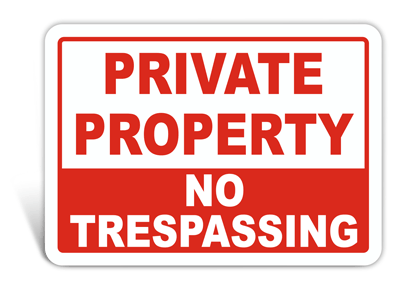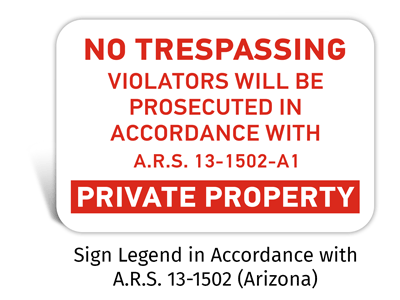No Trespassing Statutes and Signs
No Trespassing Signs – State Specific Regulations
Why should you post no trespassing signs?

To protect your property and everything on it, including structures, equipment, livestock, and resources, a landowner or tenant needs to restrict the entry of others onto the property itself.
Fencing or other types of manmade boundaries can help to keep others out, but by itself, a fence has limited weight in deterring trespassing.
In order to deter someone from coming onto your land and to do so legally in most states, No Trespassing Signs can be posted to stop entry.
To be protected by law, most states require a landowner or tenant to post a notice that entry onto the land is not allowed.
Often there is no specific language that needs to be conveyed, so a sign with a simple and direct message of “no trespassing allowed” or “private property no trespassing” will be enough to satisfy the law and properly notify any person attempting to enter the property.
Posting of these signs is more cost-effective than fencing in a property, especially for larger lots that are spread over acres or where natural boundaries such as streams make fencing difficult.
Does your state require specific no trespassing signs?

Most states do not require specific signs, but some do, such as Arizona and Maine. If you live in a state that does not require specific sign text, you can still order a no trespassing sign that incorporates a legal statute or code to further deter a potential trespasser.
Safetysign.com offers a wide variety of custom no trespassing signs where a specific state law or statute can be referenced, or the landowner’s name or address can be listed.
Posted signs are common no trespassing signs used during hunting and trapping seasons to keep hunters off of private land. They display language that restricts trespassing, including hunting, fishing, and trapping on private property. The landowner or tenant’s name and address are added to the sign.
How many no trespassing signs do I need?
The number of private property, no trespassing, or posted signs you might need varies on the size of your property. Some states require a no trespassing sign to be posted on or near your property’s border once every 500 feet. Other state’s statutes do not have a requirement like this.
We recommend that the end-user of no trespassing signs seeks out additional and/or more accurate information through local government offices, websites, and other resources before posting these signs.
SafetySign.com does not recommend or specify the use of a specific safety sign because it does not have knowledge of the hazard(s) our customers are identifying. It is the customer’s sole responsibility to identify the hazard(s) that may be present and select one or more signs (stock or custom) that accurately identify their specific hazard(s) and complies with any applicable federal, state or local laws or regulations, any worksite specific rules or regulations and/or any applicable safety standards (including, without limitation, ANSI and/or OSHA standards). SafetySign.com disclaims any and all liability (excluding liability for our Product Warranty contained in our Terms and Conditions) for any sign selected by a customer and shall not be responsible for any personal injury or property damage resulting from the use of signs purchased from it or for the independent interpretation made of any applicable federal, state or local laws or regulations, any worksite specific rules or regulations, and/or any applicable safety standards (including, without limitation, ANSI and/or OSHA standards). Customer shall indemnify and hold SafetySign.com and its corporate parent and its officers, directors and affiliates harmless from and against any and all claims, loss or expense (including attorneys’ fees) arising from or related to the purchase and use by customer or any third party of any sign purchased by customer from SafetySign.com.
